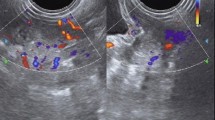Abstract
A ring chromosome 3 and a 47th chromosome formed by the portions of 3p and 3q distal to the r(3) breakpoints were found in a girl with mental retardation and minor facial anomalies. The supernumerary chromosome 3, rea(3), had a primary constriction inside its 3p portion (3p23) and was consistently stable both in lymphocytes and fibroblasts. In situ hybridization with alphoid probes revealed that the r(3) maintained its wild-type centromere, whereas the rea(3) showed no alphoid-related signals. This case and a similar one recently reported demonstrate that acentric fragments can acquire a new centromere and become stable, and that supernumerary marker chromosomes can also originate by the junction of the acentric portions distal to the centric region forming a ring. The possibility of such a chromosome segregating will depend on its ability to (re)activate a new centromere.
Similar content being viewed by others
References
Antonacci R, Marzella R, Finelli P, Lonoce A, Forabosco A, Archidiacono N, Rocchi M (1995) A panel of subchromosomal painting libraries representing over 300 regions of the human genome. Cytogenet Cell Genet 68: 25–32
Avarello R, Pedicini A, Caiulo A, Zuffardi O, Fraccaro M (1992) Evidence for an ancestral alphoid domain on the long arm of human chromosome 2. Hum Genet 89: 247–249
Baldini A, Archidiacono N, Carbone R, Bolino A, Shridhar V, Miller OJ, Miller DA, Ward DC, Rocchi M (1992) Isolation and comparative mapping of a human chromosome 20-specific alpha satellite DNA clone. Cytogenet Cell Genet 54: 97–102
Baldini A, Ried T, Shridar V, Ogura K, D'Aiuto L, Rocchi M, Ward D (1993) An alphoid sequence conserved in all human and great apes chromosomes: evidence for ancient centromeric sequences at human chromosomal regions 2821 and 9g13. Hum Genet 90: 577–583
Blennow E, Telenius H, Vos D de, Larsson C, Henriksson P, Johansson O, Carter NP, Nordenskold M (1994) Tetrasomy 15q two marker chromosomes with no detectable alpha-satellite DNA. Am J Hum Genet 54: 877–883
Callen F, Eyre H, Yip MY, Freemantle J, Haan EA (1992) Molecular cytogenetic and clinical studies of 42 patients with marker chromosomes. Am J Med Genet 43: 709–715
Crolla JA, Dennis NR, Jacobs PA (1992) A non-isotopic in situ hybridization study of the chromosomal origin of 15 supernumerary marker chromosomes in man. J Med Genet 29: 699–703
D'Aiuto L, Antonacci R, Marzella, Archidiacono N, Rocchi M (1993) Cloning and comparative mapping of a human chromosome 4-specific alpha satellite DNA sequence. Genomics 18: 230–235
Darfler M, Magnani I, Furhrman-Conti A, Monard S, Sacchi N (1994) Analysis of a human mutant centromere: key to the identification of essential centromeric sequences. Am J Hum Genet Suppl 54: 574
Dutrillaux B, Viegas-Pequignot E (1981) High resolution R and G banding on the same preparation. Hum Genet 57: 93–95
James RS, Temple IK, Dennis NR, Crolla JA (1995) A search for uniparental disomy in carriers of supernumerary marker chromosomes. Eur J Hum Genet 3: 21–26
Kosztolanyi G (1987) Does “ring syndrome” exist? An analysis of 207 case reports on patients with a ring autosome. Hum Genet 75: 174–179
Lambiase S, Maraschio P, Zuffardi O (1984) The Cd technique identifies a specific structure related to centromeric function. Hum Genet 67: 214–215
Larin Z, Fricker MD, Tyler-Smith C (1994) De novo formation of several features of a centromere following introduction of a Y alphoid YAC into mammalian cells. Hum Mol Genet 3: 689–695
Miller DA, Rocchi M, Baldini A, Singh L, Miller OJ (1990) Are chromosome-specific alphoid sequences evolutionary conserved? Am J Hum Genet 47: A95
Ohashi H, Wakui K, Okano T, Niikawa N, Fukushima Y (1994) A stable acentric marker chromosome: possible existence of an intercalary ancient centromere at distal 8p. Am J Hum Genet 55: 1202–1208
Rauch A, Pfeiffer RA, Trautmann U, Leihr T, Rott UD, Ulmer RA (1992) A study of ten small supernumerary (marker) chromosomes identified by fluorescence in situ hybridization (FISH). Clin Genet 42: 84–90
Rossi E, Faiella A, Zeviani M, Labeit S, Floridia G, Brunelli S, Cammarata M, Boncinelli E, Zuffardi O (1994) Order of six loci at 2q24-q31 and orientation of the HOXD locus. Genomcis 24: 30–40
Voullaire LE, Slater HR; Petrovic V, Choo KHA (1993) A functional marker centromere with no detectable alpha satellite, satellite III, or CENP-B protein: activation of a latent centromere? Am J Hum Genet 49: 995–1013
Waye JS, Mitchell AR, Willard HF (1988) Organization and genomic distribution of “82H” alpha satellite DNA. Evidence for a low copy or single-copy alphoid domain located on human chromosome 14. Hum Genet 78: 27–32
Zinn AB, Rush PW, Liebman J, Stallard R, Schwartz S (1993) Identification of an unusual marker chromosome lacking alpha satellite DNA. Am J Hum Genet Suppl 53: 633
Author information
Authors and Affiliations
Rights and permissions
About this article
Cite this article
Maraschio, P., Tupler, R., Rossi, E. et al. A novel mechanism for the origin of supernumerary marker chromosomes. Hum Genet 97, 382–386 (1996). https://doi.org/10.1007/BF02185778
Received:
Revised:
Issue Date:
DOI: https://doi.org/10.1007/BF02185778




